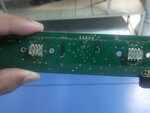Athar Rasul
Newbie level 4
Hi,
I need help in identifying the optical sensor (pic attached). It is a DIP8 package and there is nothing written/embedded on its case. Apparently it is an ambient light sensor array or photo diode array. Hell, it could even be color sensor. I need to know the make and model of this sensor. Please help!! Any educated guess would be appreciated.

I need help in identifying the optical sensor (pic attached). It is a DIP8 package and there is nothing written/embedded on its case. Apparently it is an ambient light sensor array or photo diode array. Hell, it could even be color sensor. I need to know the make and model of this sensor. Please help!! Any educated guess would be appreciated.

Last edited: